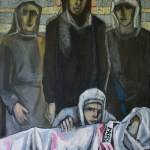
Teaching visual arts

He has been teaching art and ceramics in the workshop attached to his studio in Haifa since 2006, offering special courses for young children aged 8-14 from all religious denominations found in Haifa. The course focuses the attention on joint creativity, and ends with a joint exhibition for the pupils. The idea was to bring Muslims, Jews and Christian children together, and thereby promote tolerance and dialogue through the arts.
Abed Abdi believes that joint creativity can bridge between differences. His motivation is simple and rational: “Knowing the other is the first step to understanding him or her, and when pupils are being exposed to pupils from other religious denominations, then joint creativity is another way to let them start talking to each other, learning from each other, and eventually, they will come to respect each other, and possibly work on common themes jointly in during their mature life” – he states.
Veronica Sartore from the Oasis of Peace wrote that Abed Abdi often meets students all around the country, always bringing a series of his works with him and creating this way a ’traveling gallery’: “My purpose is to transform the classrooms into galleries, and to introduce the children into the world of art. It should be noted that generally most of the students have never met an artist; Arab children in particular have very few opportunities to come into contact with art, so the idea is that the galleries should come to the schools!”.[1]
Gannit Ankori, discussing his contribution to Palestinian art, stated that “Abdi’s texts offer invaluable documentation about the Palestinian artists, his activities as a teacher and curator in Haifa, and his conscientious documentation of this information, make him an important source for the study of Palestinian art”.[2]
Art critic Said Abu Shakra wrote that “There can be no doubt that Abed Abdi’s importance is in his being the first to cross the sea to study in the certain knowledge that the city of his birth needed him to return to act and lead in an unfamiliar sphere of endeavor, and in fact to create something ex nihilo in the complex reality… His importance is in the fact that he acknowledges and is conscious of this reality, and came back to it out of a sense of responsibility, mission and commitment….He is an artist whose name is etched on the Palestinian collective memory and the nascent Palestinian culture[3] both in Israel and beyond.”
Notes:
- Veronica Sartore, Meeting with Abed Abdi, Oasis of Peace site
- Gannit Ankorti, Palestinian Art, 2006 at p.19
- Said Abu Shakra, Preface, in: Abed Abdi: 50 Years of Creativity, published 2010, at p. 225.



















